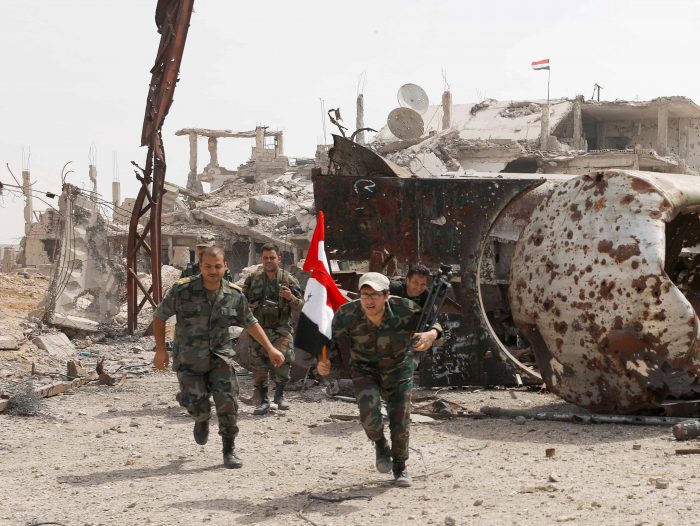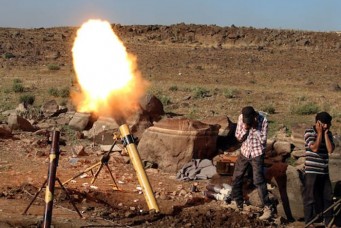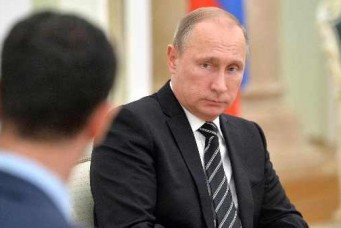Battling for Southwestern Syria
While Assad and his supporters seem close to reconquering Southwestern Syria, stability is far from assured.

Soldiers loyal to Syria’s President Bashar al-Assad forces are deployed at al-Qadam area near Yarmouk Palestinian camp in Damascus,Syria April 29,2018. Omar Sanadiki/Reuters
The Assad regime intends to retake control of southwestern Syria, following its military success around Damascus over the last few months. The United States warned that any further Assad military movement toward southwestern Syria—where rebels are in control of key parts—would prompt “firm” American retaliation. The Trump administration wants to freeze fighting in the area, given its proximity to US allies, Israel and Jordan. The key threat, in the eyes of the United States and its regional allies, is the presence of Iranian and Iranian-funded forces in this strategic area.
Assad’s potential campaign in the south is worrisome. Yet, the powers involved in the southern ceasefire zone may agree to a deal where the Assad regime is permitted to retake the region, as long as Iranian withdrawal is assured in exchange. While this scenario may be favorable to the powers involved – Iran, Russia, Israel, Jordan, and the United States – it is unlikely to produce long-term stability in southwestern Syria.
Recent reports suggest that Russia, the United States, and Jordan are working towards reaching an agreement on the future of the temporary ceasefire zone in southwestern Syria, which was agreed upon in consultation with Israel in July 2017. The key objective of the deal was to avoid any escalation between Iran and Israel, and thus prevent an explosive inter-state conflict throughout the entire Levant. While violence has significantly decreased in the region as a result of the agreement, Iran and Iranian-aligned militias continue to consolidate their presence in the southwest. Iran seemed uninterested in submitting to the trilateral agreement, escalating its threat against Israel as seen in the February 10 confrontation. Russia, on its end, failed to prevent Iranian entrenchment in the region.
While Israel is no friend of the Damascus regime, it would likely not object to regime troops on its borders and would allow them to recapture the southwest, if Iran and Hezbollah stop entrenching close to Israel. The scenario is particularly of interest to Israel because Trump has no interest in either increasing the presence of US troops in Syria nor in reopening the supply of funds to Syrian rebels, despite increasing American hostility towards Iran. This possible Israeli acceptance of Assad does not mean that Israel will halt its attacks against Iranian and Hezbollah positions in other regions of Syria.
However, Tehran’s intentions must be made clear for this scenario to play out. Although Iran has set up military infrastructure near Israel’s border, it is extremely unlikely the country has any interest in attacking Israel from Syria anytime soon. Its current strategy in the southwest seems to have two main objectives: 1) localizing its presence in the southwest through local militias, and 2) realizing recognition for its status as an influential power in the region.
Iran has been busy in the last two years building and training local groups in the southern region. Iran’s investment in these groups denotes its real approach to the southwest: these groups are loyal to their patron, and they can be mobilized to open a new “resistance” front against Israel at Tehran’s behest. As Israel vows to attack Iran in other parts of Syria, Iran’s local clients in the southwest will likely engage in small-scale retaliations against Israel, thus jeopardizing any prospect for stability in this jittery region.
Iran clearly seeks hegemony in the Middle East. The Islamic Republic does not want to be perceived as a second-tier player in Syria or that it is disciplined by the RussiansTehran wants its seven-years worth of money and blood in Syria to be acknowledged. It has achieved some levels of dominance in Syria, and it does not want to be excluded from the big picture. Russia’s exclusion of Iran during the creation of the ‘de-escalation’ zone was in part reason for the Russian failure in delivering Iranian withdrawal. Iran wants to be publicly—but perhaps indirectly through the Russians—involved in such agreements. In this way, Iran can display its assertive, border-spanning weight in this geopolitical bout.
While there seems to be increasing Russian calls on Iran to pull its forces out of Syria’s southwest, it should be clear that banking on what is perceived as a ‘schism’ between the two powers is a waste of time. Despite their differences, Russia shares strong interests with Iran and the tipping point for Moscow to turn against Iran is much further away than what Western powers may think. Both allies have shown that they can work around their differences to achieve mutual goals.
Jordan, the quieter player in this conflict, is viewed as a proponent of a scenario where the Assad regime is returned to power in Syria’s south. Amman’s approach appears centered on economic calculations and less so on security or political motivations. In this respect, the Jordanians could revive their staggering economy if the Syrian regime is able to handle the border and allow for reopening the crossing to trade between the two countries.
Under the assumption that all powers involved want to prevent escalation, the return of Assad’s forces to southwestern Syria is a likely outcome. The likelihood is that a “reconciliation” will be reached with the abandoned rebels for their relocation to the north. Russian military police are likely to be deployed to areas near the Israeli-occupied Golan Heights to restrain regime forces.
While this scenario addresses tensions between Iran and Israel in Syria’s southwest, it does not provide a long-term solution for the region. Tehran and Moscow want Assad to reassert sovereignty in every part of the country, but empowering Assad in the south, would lead to renewed instability.
The Assad regime has suffered from shortage of manpower, for at least the last three years. Today’s Assad regime is drastically different from that of pre-2011—in terms of formation and decision making process, which has implications for its ability to maintain control in the southwest. Regime forces today are a chaotic kaleidoscope of pro-Assad groups; these groups are not only different from each other in ideology, they are also distinct in terms of who commands them. Both Iran and Russia have partnered with warlords and businessmen to create forces that serve their interests. These divisions, lack of indigenous forces, and centralized command will contribute to long-term instability in areas controlled by the Assad regime, and particularly in an area of a heavy strategic weight, like Syria’s southwest.
Furthermore, the return of the Assad regime, which is perceived locally as the chief killing machine in the country, to the south will feed into the narrative of extremists and increase their recruitment potential among the local population. Given the apparent sectarian nature of Assad’s troops, the regime carries a demographic disadvantage that will likely strengthen the standing of extremists.
The Russians have maintained relations with virtually every player in Syria, despite taking a proactive role in the conflict, and the future of the southwest will be a test to Moscow’s supposed ability to maneuver between the region’s complexities. Assad’s return to Syria’s south is likely, with each concerned power seeking its own interest. However, Assad’s return does not promise stability and would later prove costly to most of the powers involved—particularly Israel and Jordan. In the long run, average Syrians will be the biggest losers.
Abdulrahman al-Masri is a journalist and analyst who covers Middle East politics and security and foreign policy. He is also a fellow at the SecDev Foundation. On Twitter@AbdulrhmanMasri.





